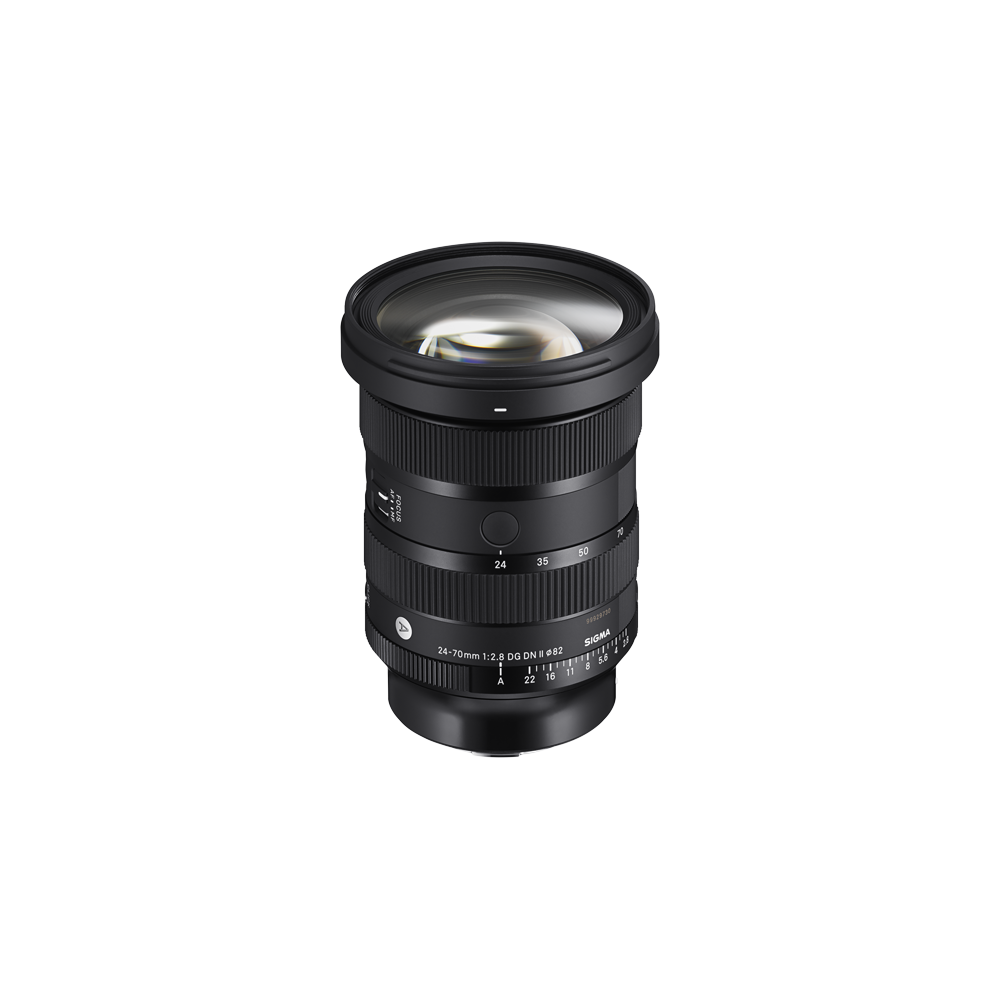24-70mm F2.8
DG DN II


- High sharpness throughout the entire image
- Fast F2.8 maximum aperture
- 7% smaller, 10% lighter than previous model
- 3x faster autofocus than previous model
- Minimum focusing distance of 17cm
- Dust and splash-resistant structure
- Water and oil repellent front coating
- Designed to minimize focus breathing
- Designed to minimize flare and ghosting
- Equipped with two AFL buttons
- Aperture ring with de-click function
- Compatible with Lens Aberration Correction*
- Made in Japan
AWARDS
|
|
|
| Angle of view | Standard |
|---|---|
| Camera Type | Mirrorless |
| Lens Mount | L-Mount, Sony E-mount |
| Sensor Size | Full Frame |
| Construction | 19 elements in 15 groups, (6 FLD, 2 SLD, 5 aspherical elements) |
| Angle of view | 84.1-34.3° |
| Number of diaphragm blades | 11 (rounded diaphragm) |
| Minimum aperture | F22 |
| Minimum focusing distance | 17(W)-34(T)cm |
| Maximum magnification ratio | 1:2.7(W)-1:4(T) |
| Filter diameter | 82mm |
| Dimensions (diameter x length) | Sony E-mount φ87.8mm × 122.2mm |
| Weight (g) | Sony E-mount 735g |
| Edition number | A024 |
| Supplied Accessories | Lens hood LH878-05, Front Cap LCF-82 Ⅲ, Rear Cap LCR , Lens case LS-57ASEL |
| Accessories | USB Dock UD-11 (L-mount), SIGMA WR CERAMIC PROTECTOR 82mm, SIGMA WR PROTECTOR 82mm, SIGMA WR UV FILTER 82mm, SIGMA WR CIRCULAR PL FILTER 82mm |
| EAN-code | Sony E-mount 085126941413 |
| Specifications Info | * The appearance and specifications of the product are subject to change. |
Rendering performance worthy of the flagship name
The Sigma 24-70mm F2.8 DG DN II | Art is the successor to the Sigma 24-70mm F2.8 DG DN | Art, which is known for its high optical performance, and has further improved resolution throughout the zoom range. The lens has high sharpness throughout the entire image from its maximum aperture, even on high-resolution cameras. Focusing on enhancing its rendering performance, the brightness of F2.8 produces a large, beautiful bokeh effect, and allows users to experience the power of a flagship lens in all types of visual expression. In addition to its advanced close-up capability and resistance to flare and ghosting, the lens is designed to minimize focus breathing, providing ideal images in any situation.
High optical performance across the entire image and zoom range
The optical design of the lens includes 6 FLD glass elements, 2 SLD glass elements, and 5 aspherical lens elements to thoroughly suppress various aberrations throughout the entire zoom range. In particular, sagittal coma flare has been well controlled to achieve consistently high resolution all the way to the periphery of the image. By also effectively correcting lateral chromatic aberration, high resolution, beautifully rendered images can be achieved, free from color fringing can be achieved.


Incorporating 5 aspherical lenses
The use of 5 high-precision aspherical lenses enables both high optical performance with minimal aberration correction and a compact optical design. The Sigma's only manufacturing base, the Aizu factory’s ultra-high-precision aspherical molding technology makes it possible to produce the thin, highly polarized aspherical lenses that are essential for the construction of this lens. This has brought about a higher degree of freedom in optical design.
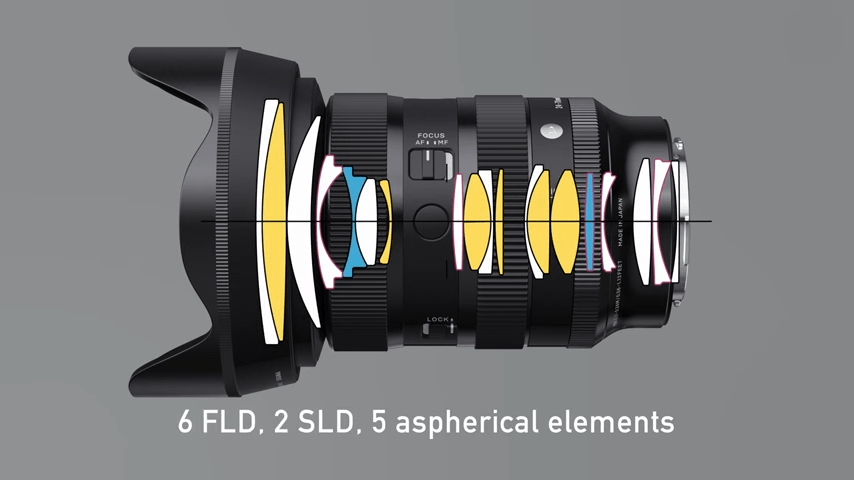

Excellent close-up capability
The lens has excellent close-up capability with a minimum focusing distance of 17cm / 6.7in. at the wide end and a maximum magnification ratio of 1:2.7. This is useful when composing close-up shots of a subject, or when shooting in tight spaces where it is difficult to get a good distance from the subject.
* Be extremely careful that the front lens element does not hit the subject when photographing. Remove the lens hood when photographing at the minimum focusing distance at the wide-angle end.


Designed to minimize flare and ghosting
Flare and ghosting, which reduce image quality, have been largely eliminated using advanced simulation technology, ensuring the lens renders rich, high-contrast results in all conditions. In addition, Nano Porous Coating and Super Multi-Layer Coating have been applied to help suppress flare and ghosting to the utmost degree. High backlight resistance enables clear and sharp images under any lighting conditions.


Minimal focus breathing
The lens has been designed to suppress focus breathing. The change in angle-of-view due to focus shift across the entire zoom range is minimized, creating a natural-looking focus pulls when recording video.
Improved portability and expanded feature set
The body of the Sigma 24-70mm F2.8 DG DN II | Art is approximately 7% smaller in size and 10% lighter in weight than the previous model, while improving usability by adding an aperture ring and two AFL buttons. Despite the reduction in size and added features, the lens maintains Sigma’s renowned excellent build quality, with the uncompromisingly precise and robust construction expected of a professional photographic tool.


Highly portable lens body
While the number of lens elements used in its construction is the same as that of the previous model, the overall length has been shortened owing to an advanced optical design. In addition, the more efficient mechanical design has resulted in a highly portable lens body with a maximum diameter of φ87.8mm x 120.2mm / φ3.5in. x 4.7in., and weight of 745g / 26.3oz. *
* These figures are for L-Mount.
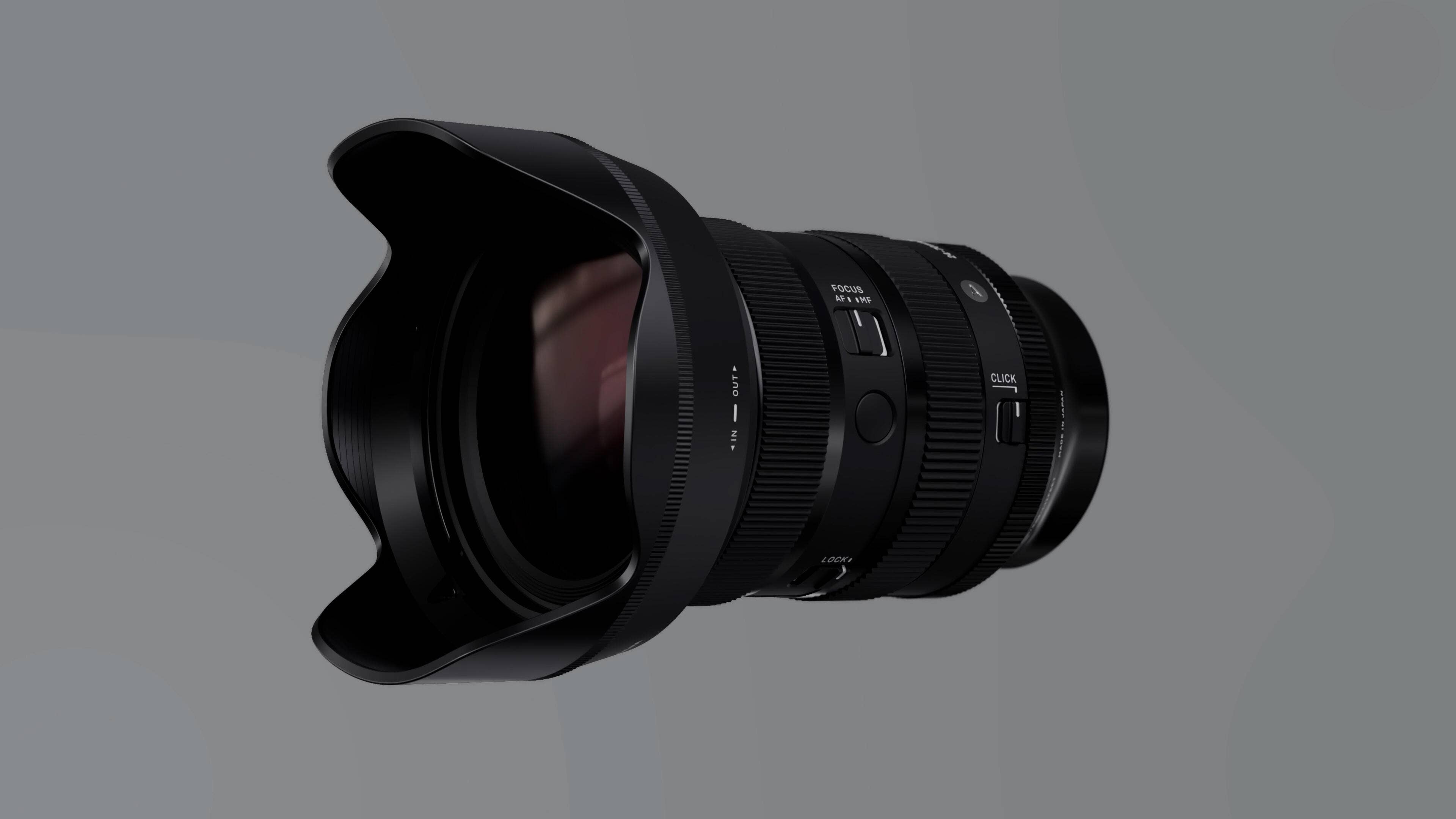

Excellent build quality
Simultaneously focusing on reducing the size and weight of the lens body, the use of metal parts for the zoom extension unit and other parts, as well as the robust internal structure ensure rigidity during use, such as when operating the ring, pressing buttons, and carrying the lens. The design emphasizes the lens’ longevity and reliability as a tool, which cannot be achieved by solely pursuing a compact and lightweight body.
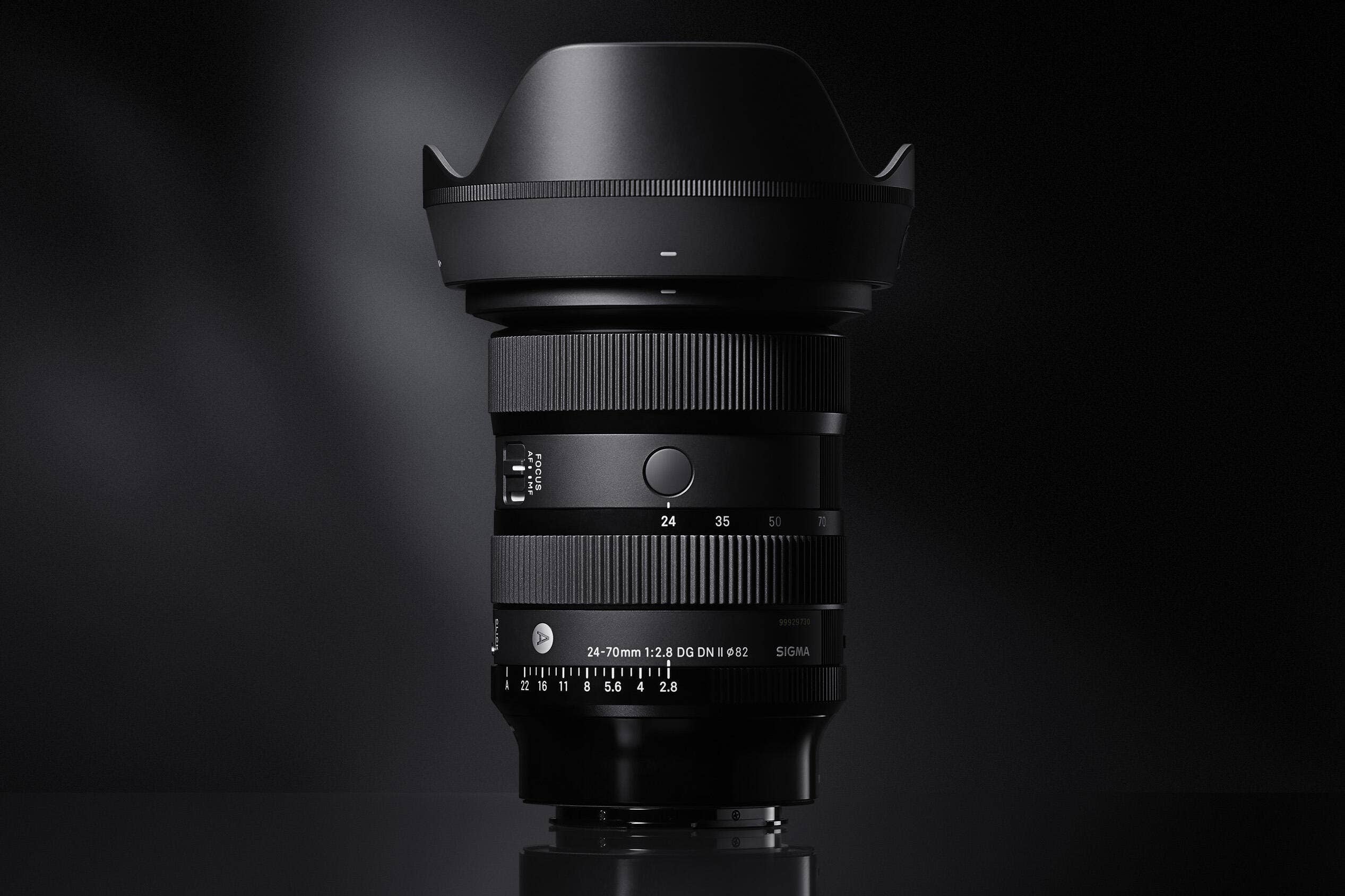

Equipped with an aperture ring
The lens is equipped with an aperture ring as well as an aperture ring click switch and an aperture ring lock switch, allowing for aperture operation suitable for various shooing situations.
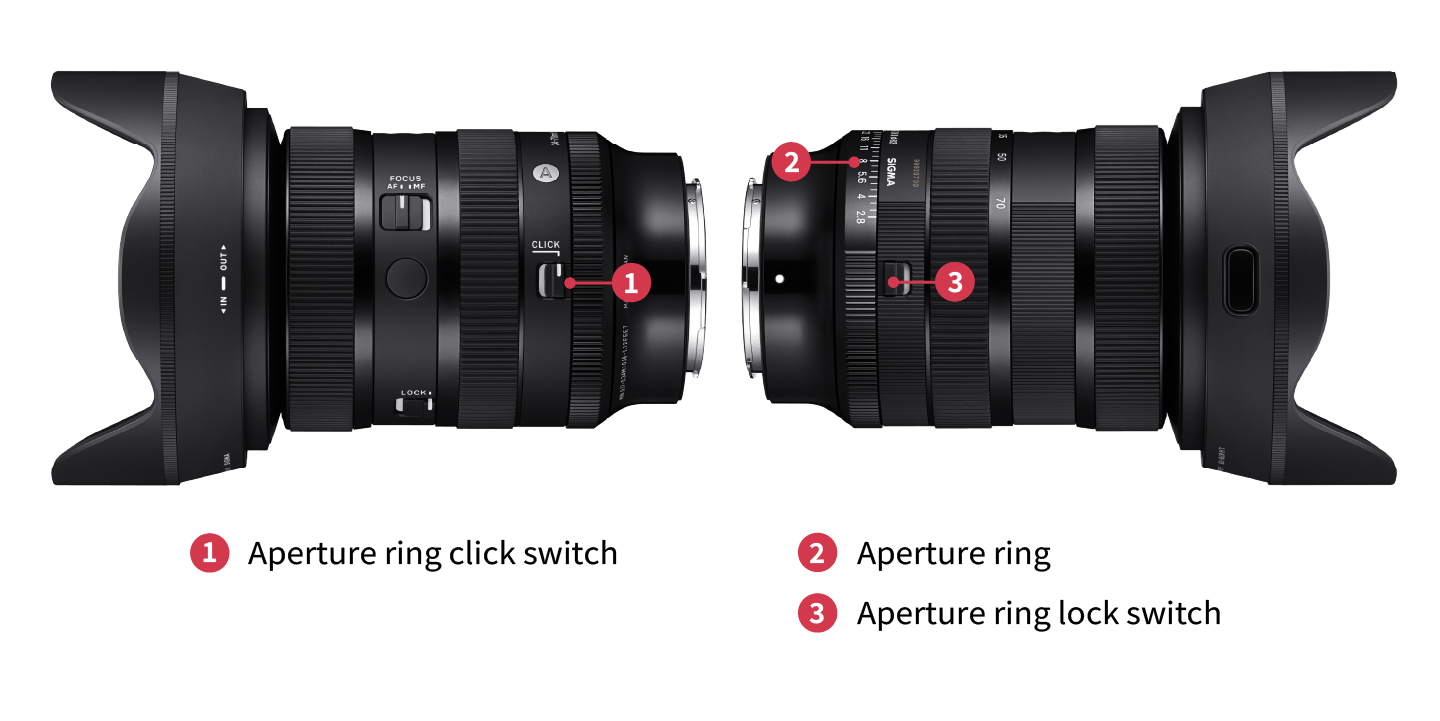

Equipped with two AFL buttons
The lens is equipped with two AFL buttons*, to which a range of functions can be assigned via the menu on selected cameras, one more than the previous model. In addition to the side, the additional button has been positioned on the top to facilitate button operation when the camera is held in vertical orientation.
* Functions can be assigned on supported cameras only. Available functions may vary depending on the camera used.
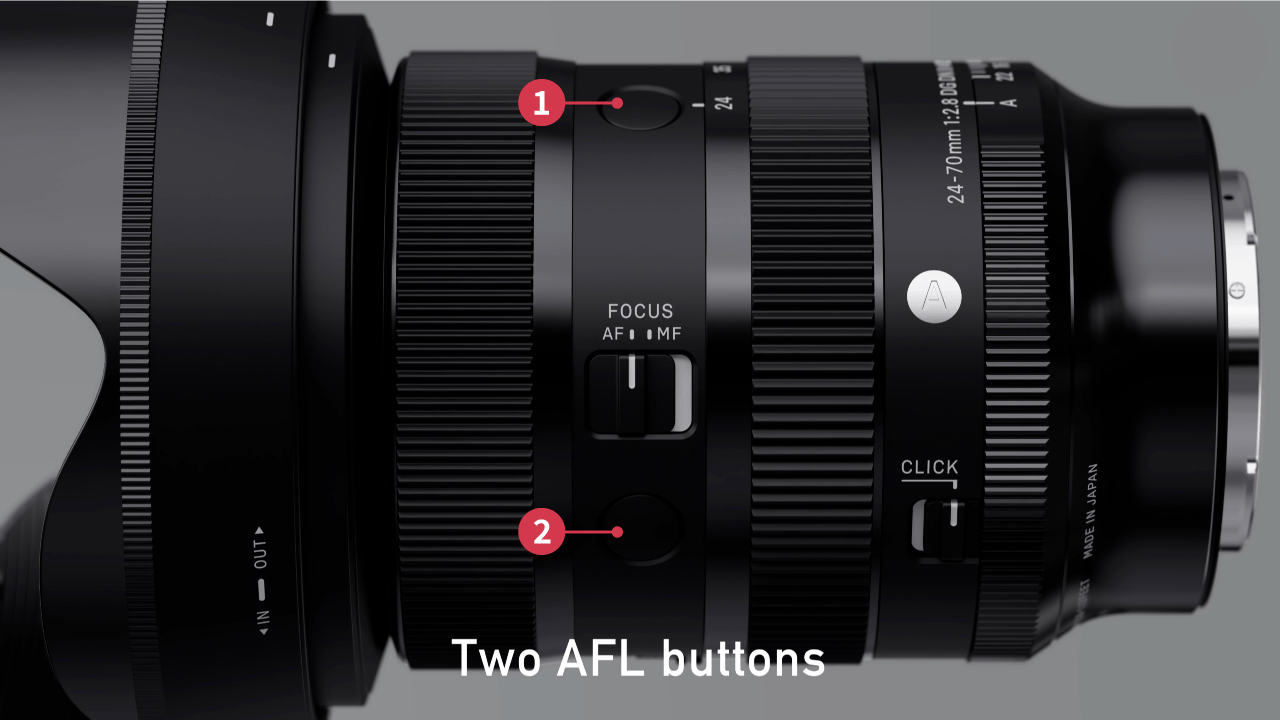

A wealth of functions including high-speed autofocus
In addition to high-speed AF with HLA (High-response Linear Actuator), the SIGMA 24-70mm F2.8 DG DN II | Art has a full range of features including weather resistance such as a dust and splash resistant structure * and water and oil repellent coating, as well as a zoom lock switch. The lens delivers the best possible results in every shooting situation.
* The structure is designed to be dust and splash resistant, but not waterproof. Be careful not to bring the lens in contact with a large amount of water. Water inside the lens may cause major damage and even render the lens unrepairable.
Incorporating a linear motor HLA
The lens incorporates a linear motor HLA (High-response Linear Actuator) for the AF actuator. The high output HLA makes the maximum drive speed more than three times faster than the previous model*, ensuring responsive AF shooting.
* Compared by the maximum drive speed of the Sigma 24-70mm F2.8 DG DN II | Art with that of the Sigma 24-70mm F2.8 DG DN | Art (It is different from the actual time for AF to focus).
Dust and splash resistant structure and water and oil repellent coating
In addition to a dust and splash resistant structure, the front element of the lens features a water and oil repellent coating, allowing users to shoot without concerns even in harsh outdoor environments.
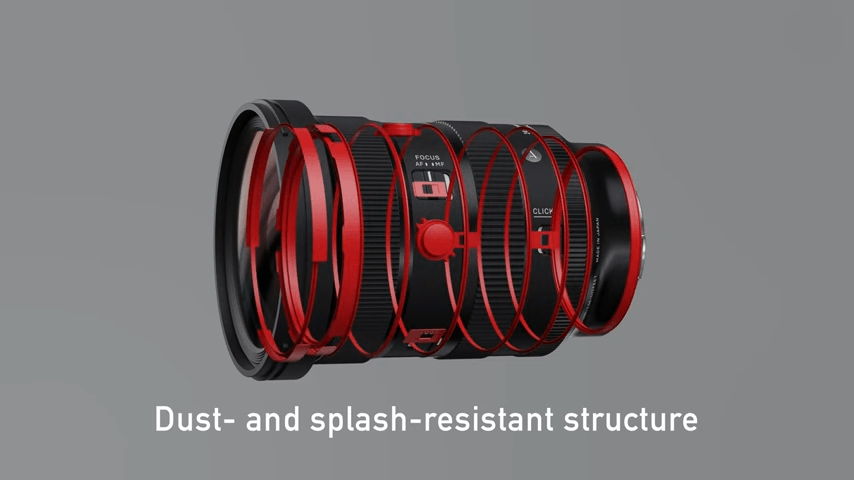

Equipped with a zoom lock switch at the wide endDust and splash resistant structure and water and oil repellent coating
The lens is equipped with a zoom lock switch that locks the lens at the wide end and prevents the barrel from extending unintentionally under its own weight . The lock can be released not only by the switch but also via zoom operation, allowing for flexible handling of even impromptu shooting.In addition to a dust and splash resistant structure, the front element of the lens features a water and oil repellent coating, allowing users to shoot without concerns even in harsh outdoor environments.
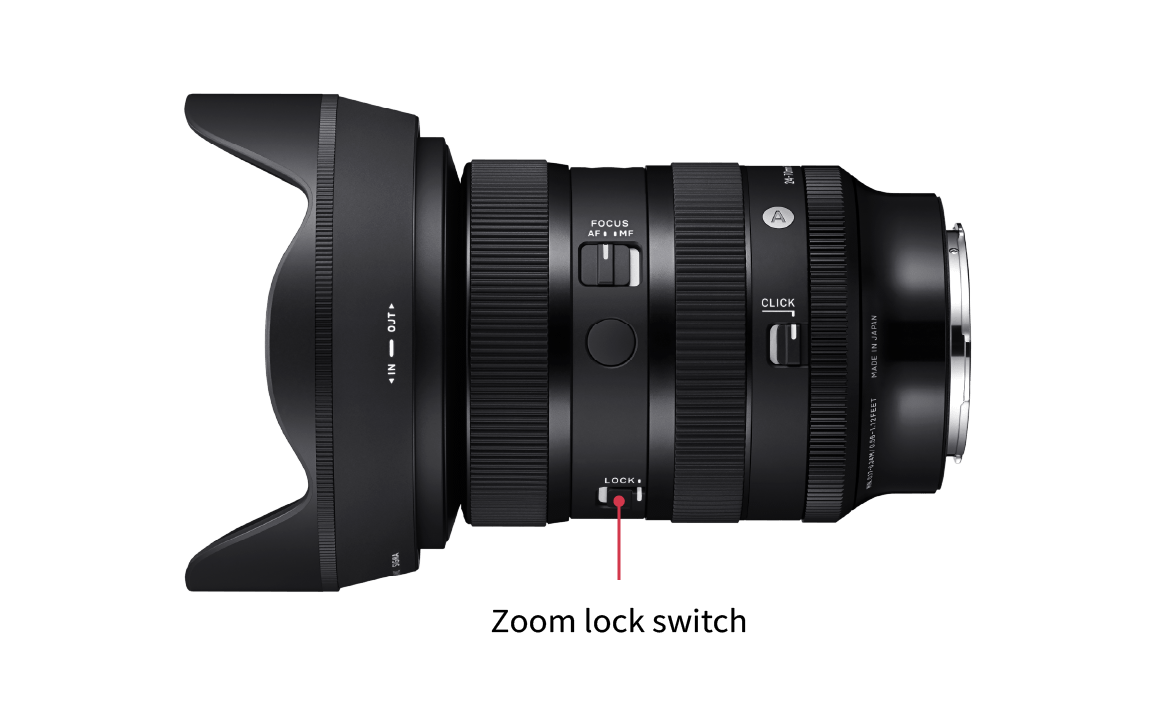

Including a petal-type hood with lock
A dedicated petal-shaped hood is supplied. A locking mechanism is provided for secure attachment.


LENS CONSTRUCTION
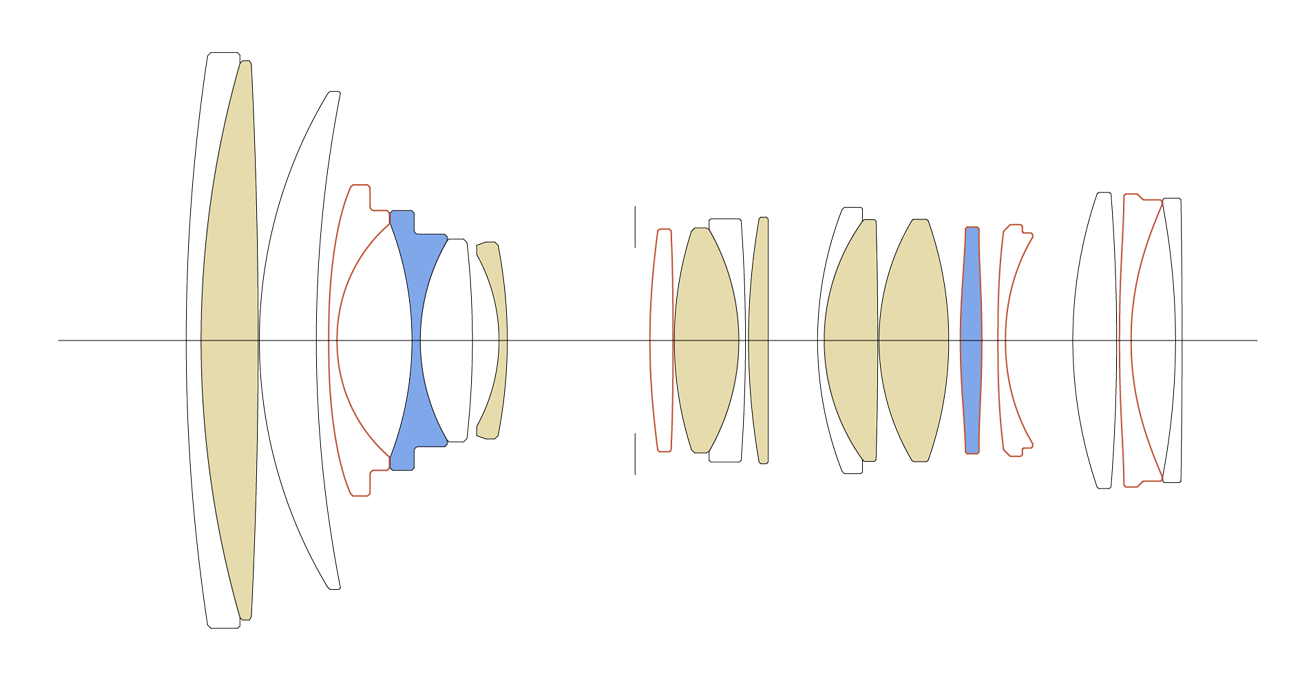

|
|
|
|
|
MTF CHART
There are two types of MTF chart. One considers the diffraction quality of light, which is called "Diffraction MTF", and the other, "Geometrical MTF" does not.
The quality of light appears in the diffracted light, and becomes more distinct as the F value gets bigger, resulting in lower image quality. Also, diffracted light exists at every aperture, which is why Sigma has been releasing Diffraction MTF data from the beginning since it is very close to the actual image data.
The advantage of using "Geometric MTF" data is that it is easy to measure and calculate since it does not consider the diffraction quality of light, yet it tends to show higher values in the graph than actual images.
The readings at 10 lines per millimeter measure the lens's contrast ability ( red lines), repeating fine parallel lines spaced at 30 lines per millimeter measure the lens's sharpness ability (green lines), when the aperture is wide open.
Fine repeating line sets are created parallel to a diagonal line running from corner to corner of the frame, are called Sagittal lines (S) and sets of repeating lines vertical to these lines are drawn, called Moridional (M) line sets.
*The MTF chart gives the result at the wide-open aperture.
|
Spatial frequency |
S:Sagittal Line |
M: Meridional Line |
|
10lp/mm |
|
|
|
30lp/mm |
|
|
DIFFRACTION MTF
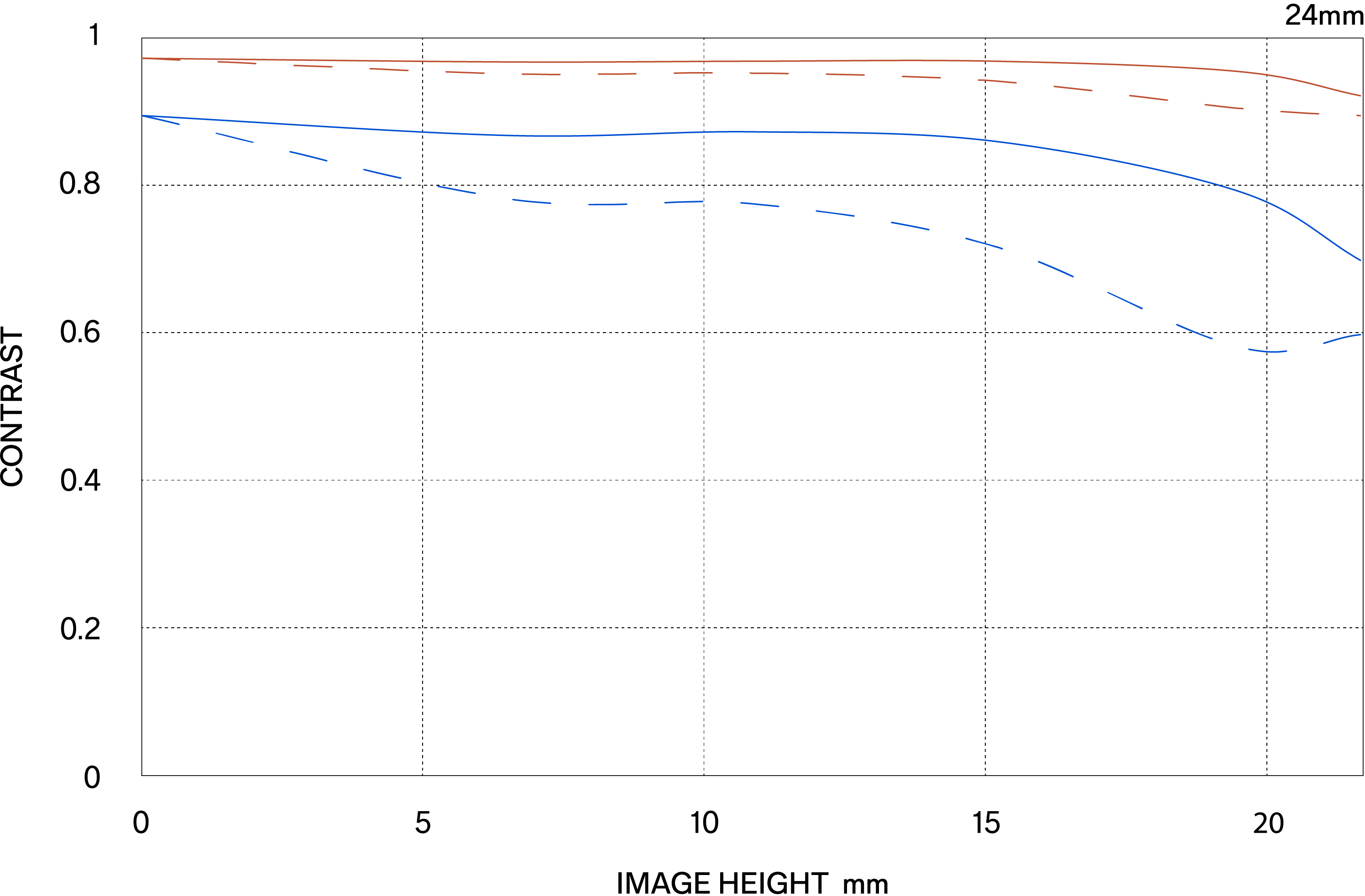

DIFFRACTION MTF
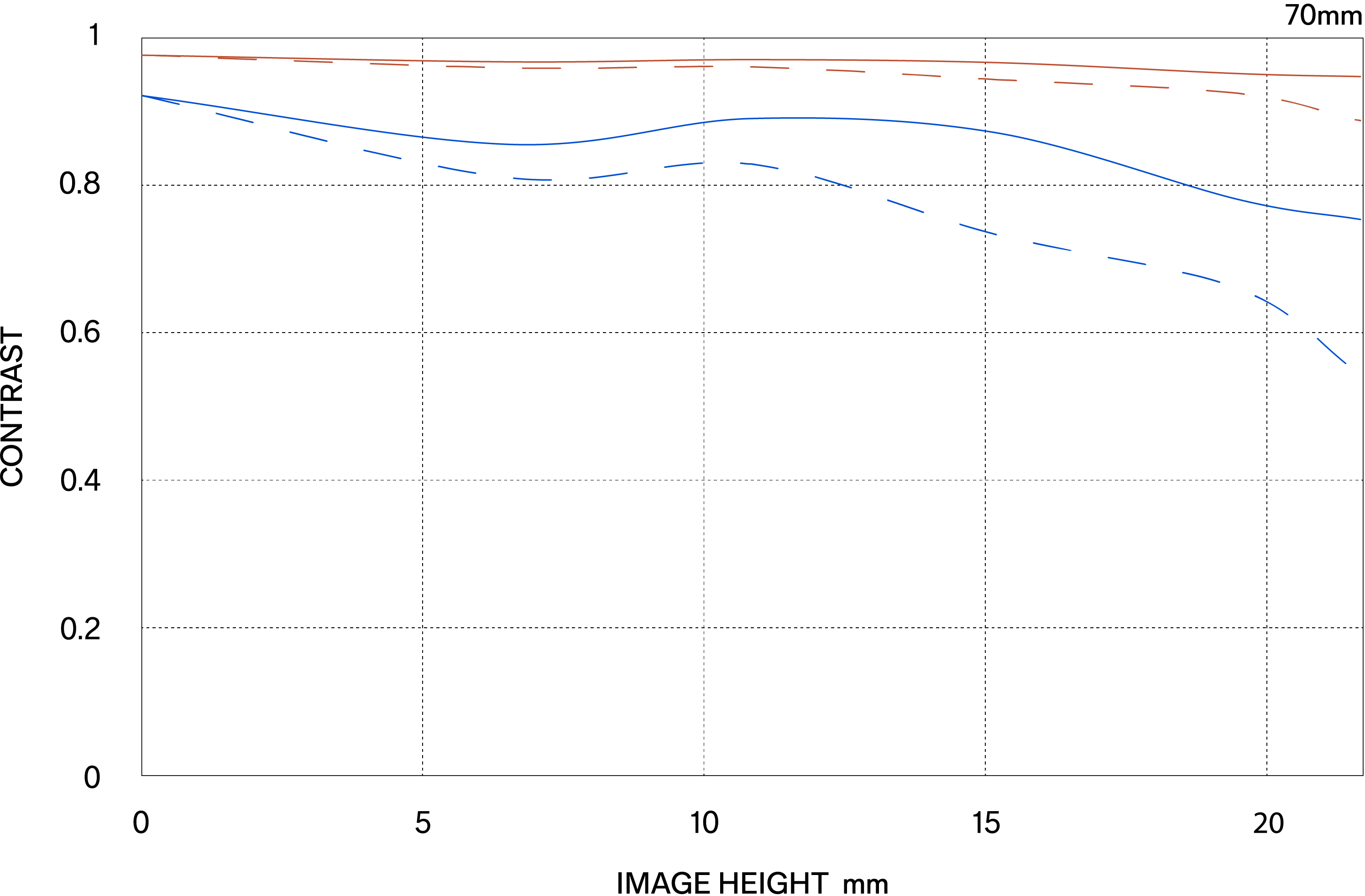

GEOMETRICAL MTF
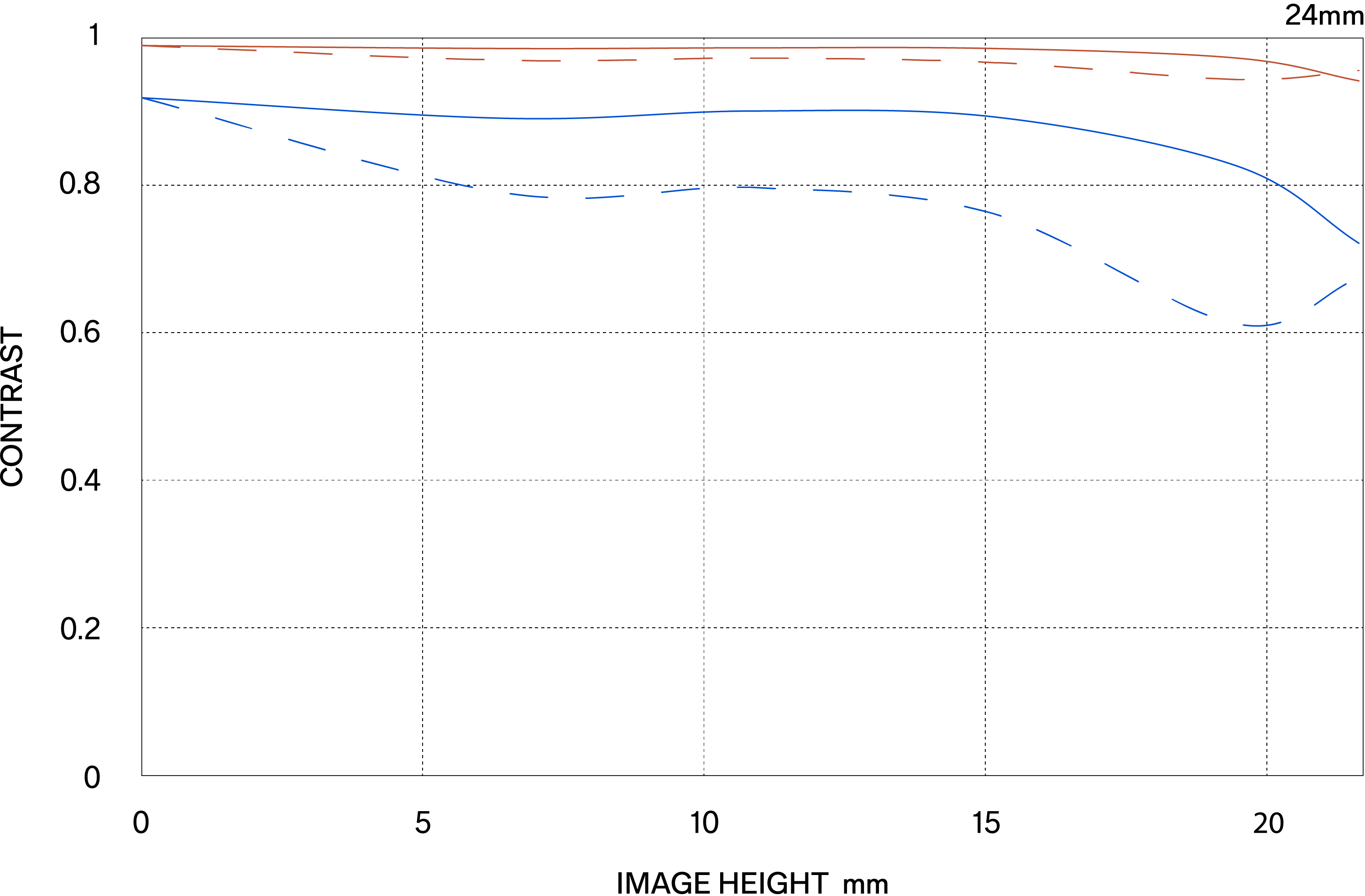

GEOMETRICAL MTF
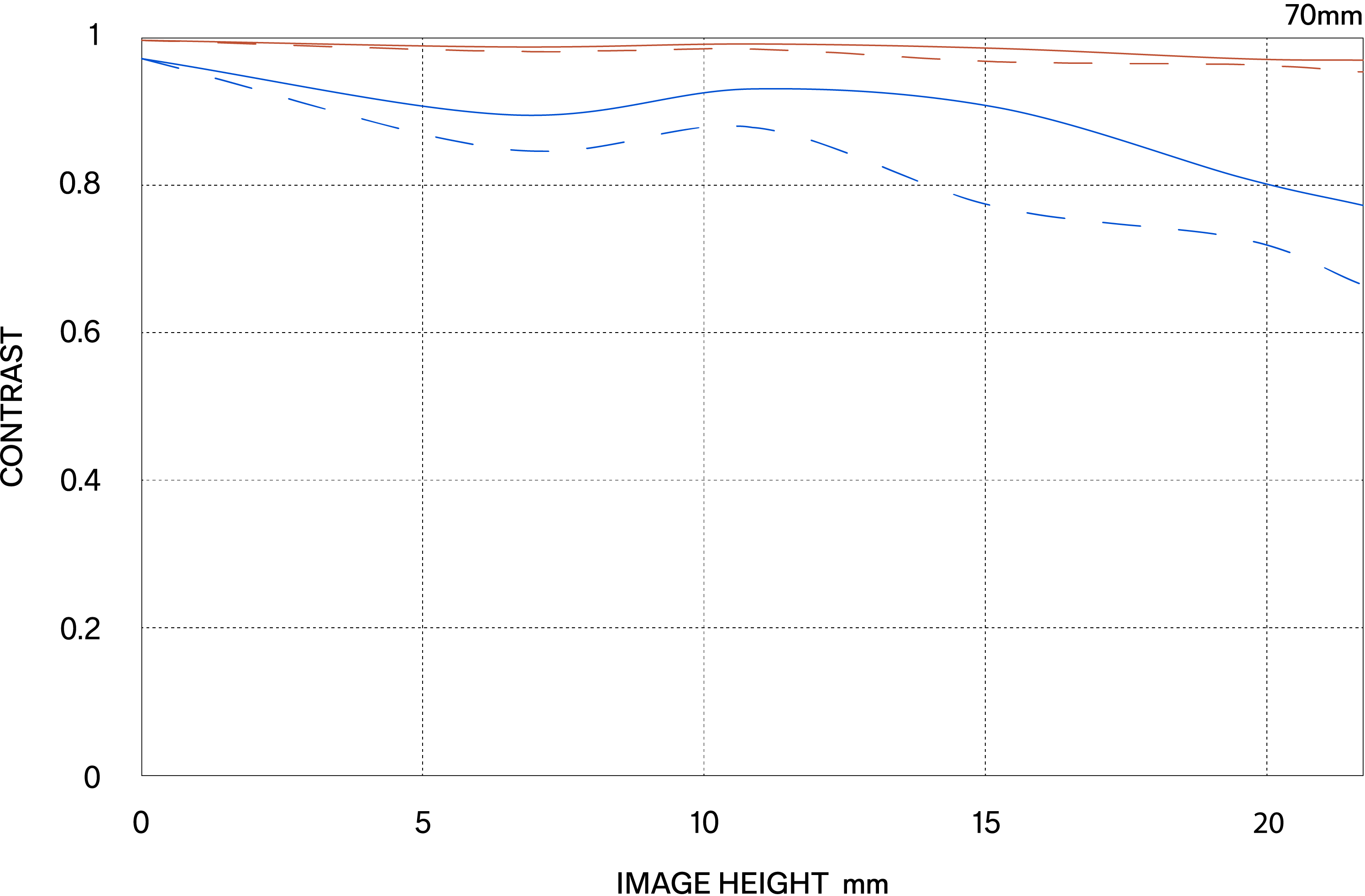

AFL button
the AFL button can be assigned with various functions widens the range of operations available on the lens.
Inner focus system
To increase stability, this lens configuration uses movable internal lens elements that adjust focus without changing the length of the lens barrel.
HLA (High-response Linear Actuator)
HLA is SIGMA's proprietary linear motor. It drives the focus lens directly without going through gears or other mechanical parts, resulting in quiet, high-precision autofocusing.
Compatible with Lens Aberration Correction
Matching the optical characteristics of the lens, this function performs in-camera corrections of peripheral illumination, chromatic aberrations, distortion, and more, to further enhance image quality.
*Function available on supported cameras only. Available corrections or auto correction functionality may vary depending on the camera model.
*On cameras where lens aberration correction is controlled with 'ON' or 'OFF' in the camera menu, please set all aberration correction functions to 'ON'(AUTO).
Nano Porous Coating
The super multi-layer coating is combined with SIGMA's unique coating technology "NPC (Nano Porous Coating)". The lens has been designed to be less susceptible to strong incident light such as backlight.
"NPC (Nano Porous Coating)" incorporates porous silica as the coating material. The porous silica layer has nano-sized holes with air inside. Having holes of this size enables a large reduction in the refractive index, allowing the reflectance to be lowered more than conventional anti-reflective coatings. As a result, reflected light causing flares and ghosting is sharply reduced, achieving clear image quality.
Super Multi-Layer Coating
SIGMA's own Super Multi-Layer Coating suppresses flare and ghosting by preventing reflections with in the lens. All lenses in the current SIGMA range feature this original technology. In digital cameras, flare and ghosting may also be caused by reflections between the image sensor and lens surfaces. Here too, SIGMA's Super Multi-Layer Coating is highly ef fective, assuring images of outstanding contrast.
Water and oil repellent coating
Incorporates a water and oil-repellent coating that allows water to be wiped away easily and prevents oil and fat from sticking to the surface, even in challenging shooting conditions. At the same time, the maintenance of the lens surface becomes easier.
Aperture ring
Aperture ring, designed to help users work intuitively
Aperture ring click switch
Mounted with a de-click function for removing clicks by the aperture ring click switch, enabling seamless operations that are especially useful such as during video shooting.
Aperture ring lock switch
A ring lock system to prevent from unintended movement of the aperture ring during shooting.
Focus Mode Switch
Using this swich, it is possible to switch the focus mode between AF and MF.
Linear focus / Non-linear focus (for L-Mount only)
A focus movement method of interchangeable lenses for mirrorless cameras (DN lens) in relation to the rotational angle of the focus ring during manual focusing.
With "non-linear focus," the amount of focal point movement varies depending on the focus ring rotational speed.
With linear focus, if the focus ring rotational angle is the same, the amount of focal point movement remains the same regardless of the focus ring rotational speed.
Dust and Splash Resistant Structure
This lens features a highly effective dust and splash resistant structure with special sealing at the mount connection, manual focus ring, zoom ring, and cover connection.
*Although this construction allows the lens to be used in light rain, it is not the same as being waterproof, so please prevent large amounts of water from splashing on the lens. It is often impractical to repair the internal mechanism, lens elements and electric components if they are damaged by water.
Rounded diaphragm
The polygonal shape of a conventional iris dia phragm causes out-of-focus light points to appear polygonal. A rounded diaphragm is designed to pro duce rounded out-of-focus light points when opened to near maximum aperture. This creates attractive bokeh effects in many situations, such as when pho tographing a subject against an out-of-focus surface of water from which light is being reflected.
High-precision, rugged brass bayonet mount
The brass mount combines high precision with rugged construction. Its treated surfaces and enhanced strength contribute to the exceptional durability of the lens.
Lens construction: 19 elements in 15 groups (6 FLD, 2 SLD, 5 aspherical elements)
Compatible with high-speed autofocus
Supports DMF and AF+MF
Compatible with AF assist (for Sony E-mount only)
Petal-type hood with lock LH875-05
Compatible with SIGMA USB DOCK UD-11 (sold separately / for L-Mount only)
Designed to minimize flare and ghosting
Mount Conversion Service available


|
Camera |
SONY α7R IV |
|
Shutter Speed |
1/640s |
|
Lens F Number |
F2.8 |
|
ISO |
200 |
|
Focal Length |
61mm |
|
Photographer |
Martin Aabreu |
A CLASSIC, EVOLVED.
The Art 24-70mm F2.8, evolved on all levels:
rendering performance, functionality, and portability.
The Sigma 24-70mm F2.8 DG DN II | Art is Sigma's flagship lens that has evolved significantly from the previous model by incorporating the most advanced technologies available to Sigma from design to production. Compared to the previous Sigma 24-70mm F2.8 DG DN | Art, the Sigma 24-70mm F2.8 DG DN II | Art has improved resolving power throughout the entire zoom range, and also benefits from functional enhancements such as the addition of an aperture ring and high-speed AF with a redesigned AF motor, HLA (High-response Linear Actuator). The lens is also approximately 7% smaller and 10% lighter. This 24-70mm F2.8 Art zoom is a versatile and high-performance tool that will help photographers and filmmakers unlock their creative potential.

